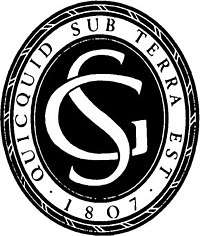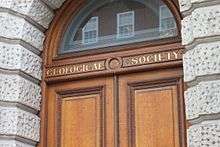Geological Society of London
The Geological Society of London, known commonly as the Geological Society,[2] is a learned society based in the United Kingdom. It is the oldest national geological society in the world and the largest in Europe with more than 12,000 Fellows.
 | |
| Motto | Quicquid sub terra est ("Whatever is under the earth")[1] |
|---|---|
| Formation | 13 October 1807 |
| Founded at | Freemasons Tavern, Great Queen Street London, WC2 |
| Type | Learned society |
| Registration no. | 210161 |
| Headquarters | Burlington House, Piccadilly London, W1 |
| Coordinates | 51°30′32″N 0°8′22″W |
Membership | 12,000 |

Fellows are entitled to the postnominal FGS (Fellow of the Geological Society), over 2,000 of whom are Chartered Geologists (CGeol). The Society is a Registered Charity, No. 210161. It is also a member of the Science Council, and is licensed to award Chartered Scientist to qualifying members.
The mission of the society is: "Making geologists acquainted with each other, stimulating their zeal, inducing them to adopt one nomenclature, facilitating the communication of new facts and ascertaining what is known in their science and what remains to be discovered".[3]
History
The Society was founded on 13 October 1807 at the Freemasons' Tavern, Great Queen Street, in the Covent Garden district of London.[3] It was partly the outcome of a previous club known as the Askesian Society. There were 13 founder members: William Babington, James Parkinson, Humphry Davy, George Bellas Greenough, Arthur Aikin, William Allen, Jacques Louis, Comte de Bournon, Richard Knight, James Laird, James Franck, William Haseldine Pepys, Richard Phillips, and William Phillips. It received its Royal Charter on 23 April 1825 from George IV.
Since 1874, the Society has been based at Burlington House, Piccadilly, London. This building houses the Society's library, which contains more than 300,000 volumes of books and journals.[4] It is a member of the UK Science Council.
Women were first allowed to become Fellows of the Society in 1919.[5][6]
In 1991, it merged with the Institution of Geologists, which had been formed in 1977 to represent the geological profession.[7]
The Society celebrated its bicentenary in 2007. It ran programmes in the geosciences in Britain and abroad, under the auspices of the science writer and palaeontologist Professor Richard Fortey, the president that year.
Specialist and regional groups
The Society has 24 specialist groups and 15 regional groups which serve as an opportunity for those with specific interests to meet and discuss their subject or region. They are all free for members to join and some are open to non-members.[8]
The Regional Groups are:
- Central Scotland
- East Anglian
- East Midlands
- Home Counties North
- Hong Kong
- North West
- Northern
- Solent
- South East
- South West
- Southern Wales
- Thames Valley
- West Midlands
- Western
- Yorkshire
The Specialist Groups are:
- Borehole Research Group
- British Geophysical Association
- British Sedimentological Research Group
- British Society for Geomorphology
- Coal Geology Group
- Engineering Group
- Environment Group
- Environmental and Industrial Geophysics Group
- Forensic Geoscience Group
- Gaia: Earth Systems Science Group
- Geochemistry Group
- Geological Curators Group
- Geological Remote Sensing Group
- Geoscience Information Group
- History of Geology Group
- Hydrogeological Group
- Joint Association for Quaternary Research
- Joint Association of Geoscientists for International Development
- Marine Studies Group
- Metamorphic Studies Group
- Mineral Deposits Studies Group
- Petroleum Group
- Tectonic Studies Group
- Volcanic and Magmatic Studies Group
Publications
The society publishes two of its own journals, the (formerly Quarterly) Journal of the Geological Society and the Quarterly Journal of Engineering Geology and Hydrogeology. It also publishes the magazine Geoscientist for Fellows, and has a share in Geology Today, published by Blackwell Science.
It also co-publishes journals and publishes on behalf of other organisations. These include Petroleum Geoscience with the European Association of Geoscientists and Engineers (EAGE), Geochemistry: Exploration, Environment, Analysis with the Association of Applied Geochemists (AAG), Journal of Micropalaeontology for the Micropalaeontological Society, Proceedings of the Yorkshire Geological Society for the Yorkshire Geological Society, and Scottish Journal of Geology for the Geological Societies of Edinburgh and Glasgow.
Past presidents
The society counts many famous geologists amongst its past presidents. These include pioneers of geology William Buckland, Adam Sedgwick, Roderick Impey Murchison, Charles Lyell, Henry Thomas De la Beche, T.H.Huxley, Joseph Prestwich, Archibald Geikie, Jethro Teall, and Charles Lapworth. Later well-known names include Alfred Harker, Arthur Trueman, H.H.Read, and Frederick Shotton, and Janet Watson.
Scientific awards and funds
In 1831 it began issuing an annual scientific award for geology, known as the Wollaston Medal. This is still the Society's premier medal, which in 2006 was awarded to James Lovelock, the originator of the Gaia Hypothesis.
Medals awarded by the Society
- Wollaston Medal
- Lyell Medal
- Murchison Medal
- Prestwich Medal
- William Smith Medal
- Aberconway Medal
- Major John Sacheverell A'Deane Coke Medal
- Major Edward D'Ewes Fitzgerald Coke Medal
- Sue Tyler Friedman Medal
- Bigsby Medal
Funds administered by the Society
- The Wollaston Fund
- The Murchison Fund
- The Lyell Fund
- The R. H. Worth Prize
- The William Smith Fund
- The Distinguished Service Award
Bibliography
- Herries Davies, G.L. (2007) Whatever is Under the Earth: The Geological Society of London 1807 to 2007, London : Geological Society, ISBN 1-86239-214-5
See also
- Geology of the United Kingdom
- William Smith (geologist)
References
- "Editorial". Journal of the Geological Society. Geological Society of London. 1 June 1972. pp. 1–2. doi:10.1144/gsjgs.128.3.0219. Retrieved 27 June 2017.
- The Geological Society Archived 2010-08-17 at the Wayback Machine, UK.
- Andrew Scott,Stephen Pumfrey, Leucha Veneer (12 April 2012). "Early Geology". In our time. 1 minutes in. BBC Radio 4. Retrieved 16 September 2012.
- The Geological Society, UK.
- "Geological Society of London Celebrates the First Female Fellows - Scientific American Blog Network". Blogs.scientificamerican.com. 2019-03-19. Retrieved 2019-03-27.
- "The first female Fellows and the status of women in the Geological Society of London | Geological Society, London, Special Publications". Sp.lyellcollection.org. 2009-08-21. Retrieved 2019-03-27.
- Brassington, R. "The Institution of Geologists — a brief history". The Geological Society, London. Archived from the original on 14 March 2012. Retrieved 16 May 2010.
- Specialist and Regional Groups, The Geological Society, UK.
External links
| Wikimedia Commons has media related to Geological Society of London. |
| Wikisource has original works on the topic: Geological Society of London |